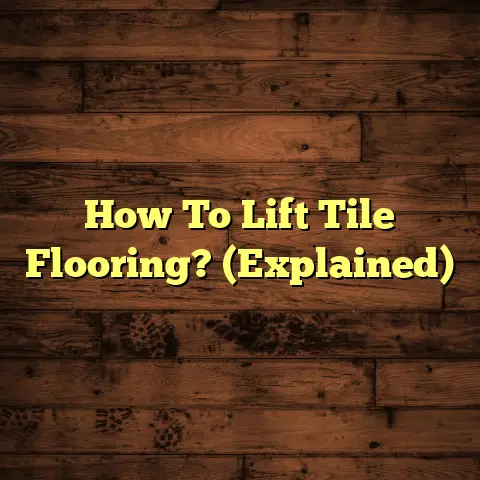Engineered Wood in Basements? (4 Big Risks!)
I get it. You’re eyeing that gorgeous engineered wood flooring, picturing it transforming your basement into a stylish haven.
Imagine: a cozy media room, a bright home office, or a killer entertainment space, all grounded by the warmth and beauty of wood.
But hold on a second.
Before you jump in headfirst, let’s pump the brakes and chat about something important: the potential pitfalls of using engineered wood in basements.
Is that aesthetic appeal really worth the risks lurking beneath the surface?
As a flooring contractor who’s seen it all, I’m here to tell you the truth, the whole truth, and nothing but the truth (so help me, level).
Trust me, you’ll thank me later.
Risk #1: Moisture Damage and Mold Growth
Okay, let’s get real. Basements are notorious for being damp. It’s just a fact of life.
They’re below ground level, surrounded by soil, and often have poor ventilation.
Think of your basement as a sponge just waiting to soak up moisture.
Now, engineered wood is designed to be more moisture-resistant than solid hardwood. It’s made with layers of plywood or high-density fiberboard (HDF) that are less prone to warping.
But here’s the kicker: it’s not waterproof.
I’ve seen basements with relative humidity levels soaring above 70%, especially during humid summer months.
And guess what? Engineered wood can only handle so much.
According to the EPA, indoor humidity should be kept between 30-50% to prevent mold growth.
When moisture seeps into engineered wood, it can cause the layers to delaminate (separate), swell, and buckle.
And then there’s the dreaded mold. Ugh.
Mold loves dark, damp places, and a basement with compromised engineered wood is basically a mold paradise.
Not only is mold unsightly and smelly, but it can also cause serious health problems.
We’re talking allergies, asthma, and even respiratory infections.
I remember one client who installed engineered wood in their basement without a proper moisture barrier.
Within a year, they had a full-blown mold infestation.
The remediation cost them thousands of dollars, not to mention the health scare.
Don’t let that be you!
Risk #2: Temperature Fluctuations and Expansion
Basements are like the moodiest teenagers of the house.
One minute they’re freezing cold, the next they’re surprisingly warm.
These temperature fluctuations can wreak havoc on engineered wood flooring.
Think about it: wood expands when it’s warm and contracts when it’s cold.
Engineered wood is no exception.
Now, a little bit of expansion and contraction is normal.
That’s why we leave expansion gaps during installation.
But in basements, the temperature swings can be extreme, leading to excessive expansion and contraction.
This can cause gaps to form between the planks, making your floor look uneven and cheap.
Even worse, it can cause the planks to buckle or warp, especially if they’re not properly acclimated before installation.
Acclimation is the process of letting the flooring adjust to the basement’s temperature and humidity levels before you install it.
I’ve seen contractors skip this step to save time, and it always comes back to bite them (and the homeowner) in the butt.
I had another client who installed engineered wood in their basement in the dead of winter without acclimating it.
Come summertime, the floor expanded so much that it started pushing against the walls, causing the baseboards to crack.
The fix? A complete floor replacement. Ouch.
Proper acclimation is key, folks. Don’t skimp on it!
Risk #3: Installation Challenges and Cost Overruns
Installing engineered wood flooring in a basement isn’t as simple as slapping it down and calling it a day.
There are a few extra steps you need to take to ensure a successful installation.
First, you need to make sure your subfloor is perfectly level and dry.
Any imperfections in the subfloor will telegraph through the engineered wood, making your floor look uneven.
And if the subfloor is damp, well, you’re just asking for trouble.
You’ll also need to install a proper moisture barrier to prevent moisture from seeping up from the concrete slab.
There are different types of moisture barriers available, so do your research and choose one that’s appropriate for your basement’s moisture levels.
As I said before, acclimatization is also crucial.
You need to let the engineered wood sit in the basement for at least 48-72 hours before installation to allow it to adjust to the temperature and humidity.
Even if you’re a seasoned DIYer, installing engineered wood in a basement can be tricky.
One wrong move, and you could end up with a floor that’s prone to moisture damage, expansion, and buckling.
And trust me, fixing those problems can be expensive.
According to HomeAdvisor, the average cost to repair or replace flooring is between $200 and $1,000.
But in a basement with moisture issues, the costs can easily climb higher.
I always recommend hiring a professional flooring contractor for basement installations.
They have the experience and expertise to do the job right, the first time.
Plus, they can often spot potential problems that you might miss.
As the saying goes, “If you think it’s expensive to hire a professional, wait until you hire an amateur.”
Risk #4: Resale Value and Market Perception
Okay, let’s talk about the elephant in the room: resale value.
You might love the look of engineered wood in your basement, but what about potential buyers?
Will they see it as a plus or a minus?
In my experience, it depends.
Some buyers are perfectly fine with engineered wood in a basement, especially if it’s been properly installed and maintained.
But others might see it as a red flag, especially if they’re concerned about moisture issues.
“Basement” and “moisture” are often synonymous in buyers’ minds.
According to a 2021 survey by the National Association of Realtors, 37% of home buyers cited concerns about moisture or mold as a reason for not purchasing a home.
And if buyers are concerned about moisture, they’re likely to be wary of engineered wood in the basement.
They might prefer other flooring options like tile, luxury vinyl plank (LVP), or even polished concrete.
These materials are generally considered to be more durable and moisture-resistant than engineered wood.
If you’re planning to sell your home in the near future, it’s important to consider how potential buyers will perceive your basement flooring.
If you’re not sure, talk to a real estate agent or a flooring contractor.
They can give you advice on the best flooring options for your basement, based on your local market and buyer preferences.
Remember, first impressions matter.
A poorly chosen basement floor can turn off potential buyers and lower your home’s resale value.
Don’t let that happen to you!
Conclusion:
So, there you have it: the four big risks of using engineered wood in basements.
While engineered wood flooring can add warmth and beauty to your basement, it’s important to weigh the risks before you make a decision.
Moisture damage, temperature fluctuations, installation challenges, and resale value concerns are all factors to consider.
If you’re determined to use engineered wood in your basement, make sure you take the necessary precautions to minimize these risks.
That means proper subfloor preparation, a high-quality moisture barrier, careful acclimatization, and professional installation.
And if you’re not comfortable with those precautions, consider other flooring options that are better suited for basement environments.
Ultimately, the decision is yours.
But I hope this article has given you the information you need to make an informed choice.
Good luck with your flooring project!





